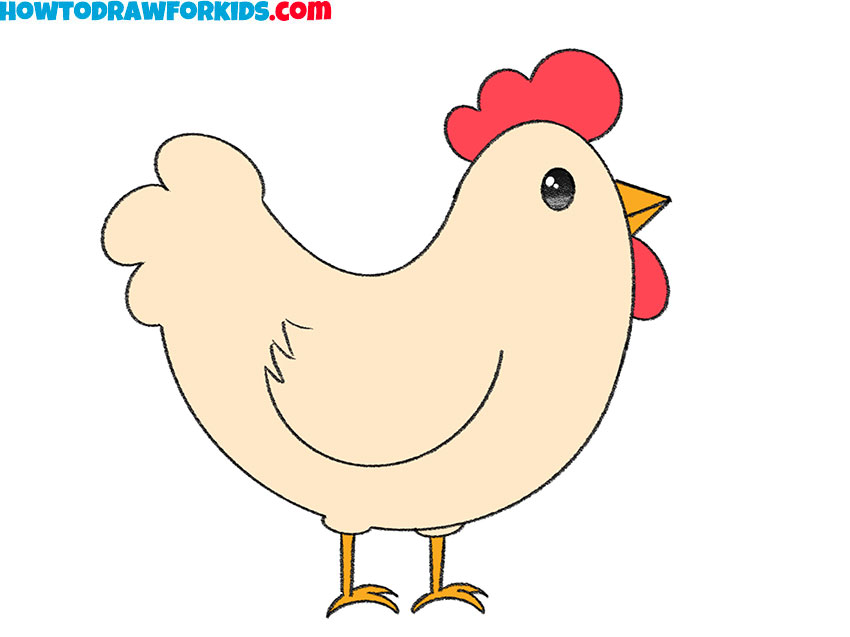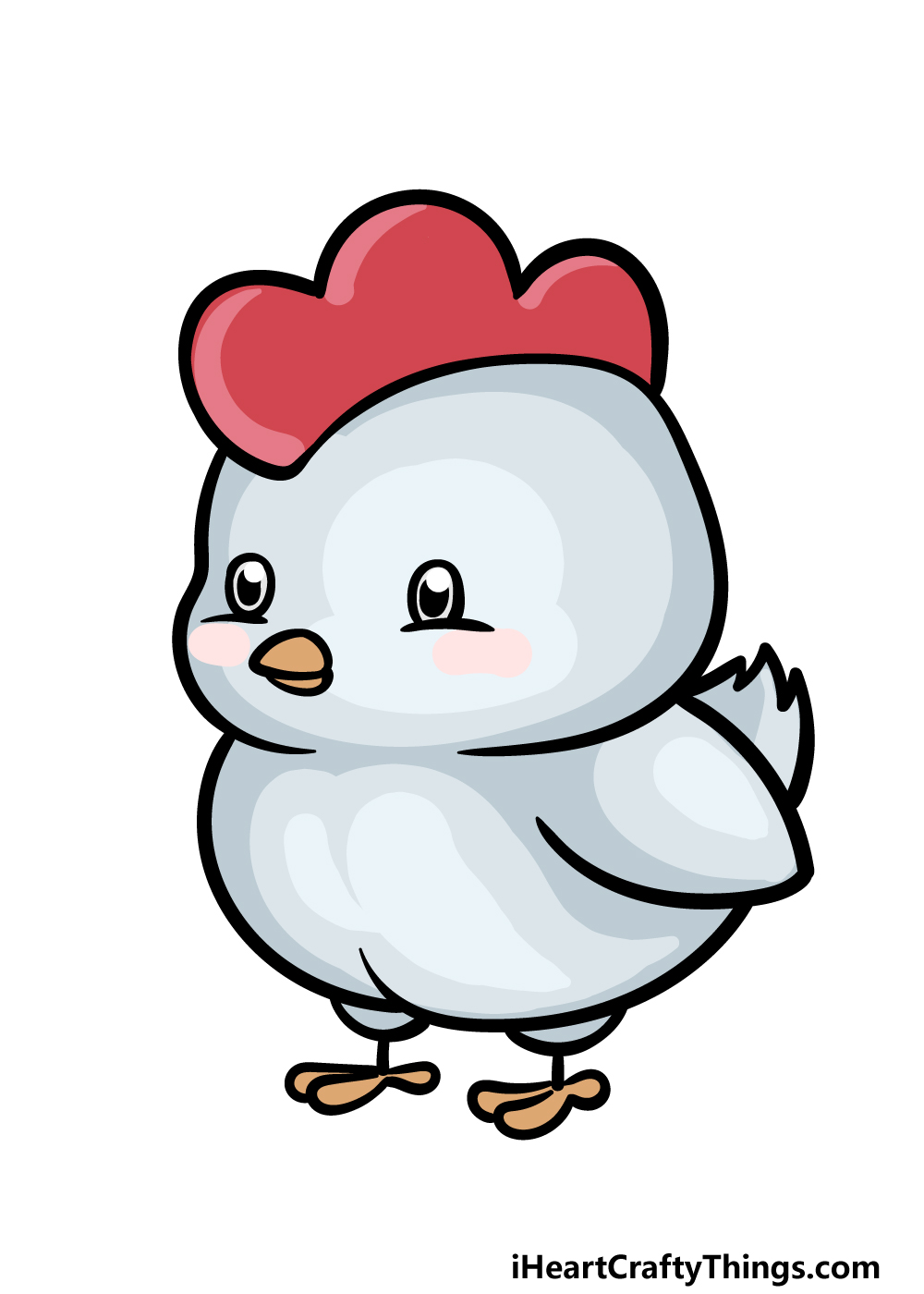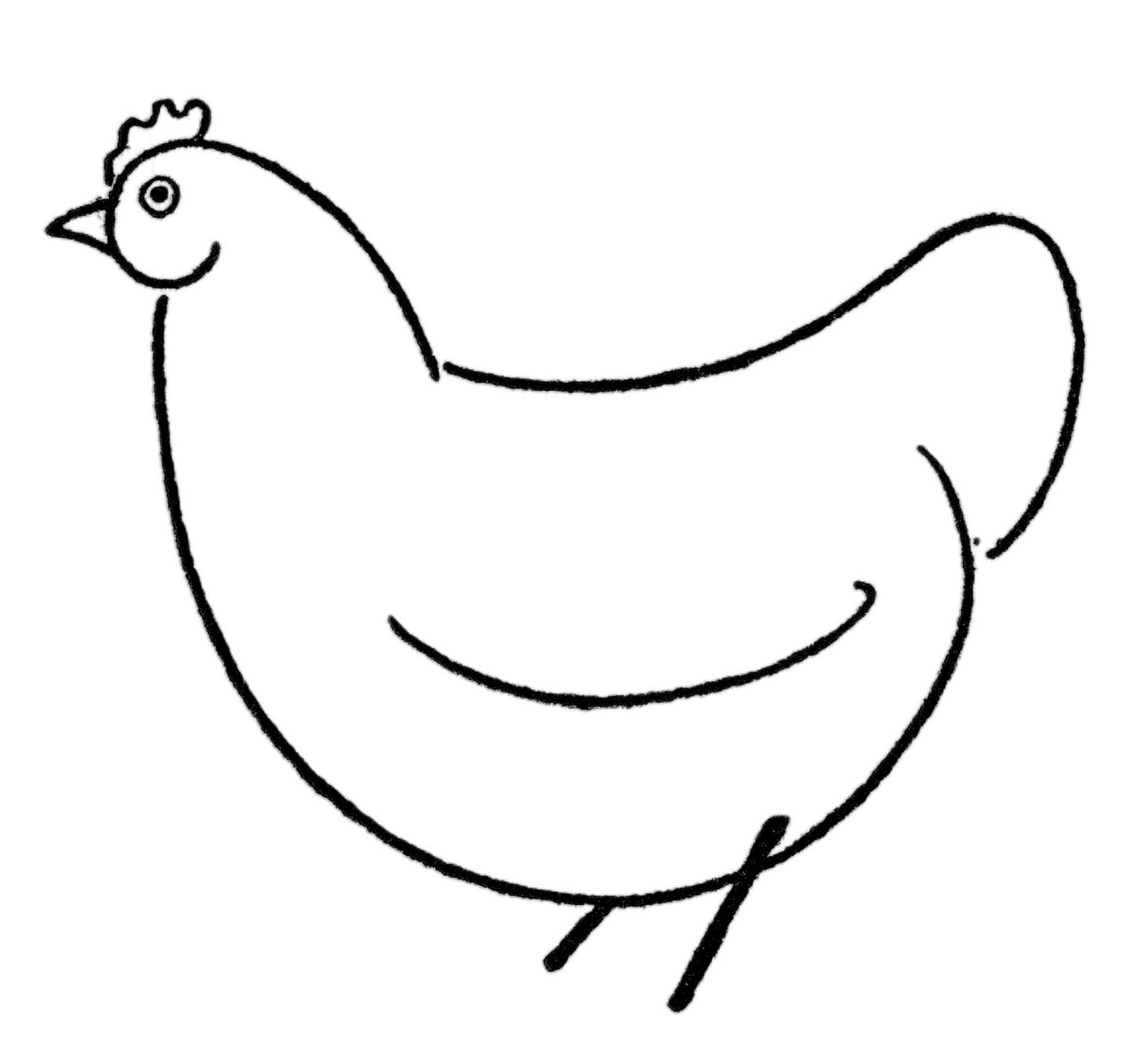Have you ever felt a little spark of joy watching chickens peck around the yard, perhaps thinking about their funny antics or even the fresh eggs they might provide? Well, that very feeling, that simple delight, can be a wonderful starting point for a creative adventure. Learning how to draw a chicken, especially when you are looking for a simple approach, is a truly rewarding activity. It allows you to capture some of that charm on paper, and it is something anyone can do, regardless of their past art experience.
You might wonder, too it's almost, why pick a chicken as your subject? Chickens, with their distinct shapes and quirky personalities, offer a fantastic opportunity for artists of all skill levels. They come in so many interesting varieties, like black, yellow, red, and white chickens, each with their own look. You see, when you own a chicken, it is very important to understand the anatomy and physiology of your bird. This basic knowledge can actually help you see the simple shapes that make up a chicken, making it much easier to draw.
This guide is here to show you that creating a chicken drawing, an easy one at that, is completely within reach. We will walk through the basic steps, giving you some simple techniques to bring your feathered friend to life on the page. So, get ready to pick up your pencil and discover the fun of sketching these wonderful birds, maybe even thinking about how your pet makes you breakfast as you draw!
Table of Contents
- Why Draw Chickens? A Feathered Friend's Charm
- Getting Started: What You'll Need for Your Chicken Sketch
- The Basics of Chicken Anatomy for Artists
- Step-by-Step: Your Easy Chicken Drawing Guide
- Tips for Making Your Chicken Drawings Even Better
- Common Questions About Drawing Chickens (FAQs)
Why Draw Chickens? A Feathered Friend's Charm
Drawing chickens offers a truly delightful experience for many reasons. For one thing, these birds are surprisingly expressive. You might have noticed how everybody's chickens have their own tiny brains full of likes and dislikes, so while one person's bird might love a certain treat, another might turn its beak up. This unique character is something you can actually try to show in your drawings, giving them a bit of personality.
Then there is the sheer variety of chickens. Many people choose their chickens according to their ability to lay eggs, while others select them based on their appearance. Black, yellow, red, and white chickens are among the many kinds you might see. Each type has slightly different features, which means you have a lot of options for what to draw. It is, in a way, like having a whole collection of models to pick from.
Beyond their looks, chickens are just fascinating creatures. Thinking about tips & tricks for raising chickens, building chicken coops, & choosing chicken breeds, or even how a chicken heart beats more than a human one, can give you a deeper connection to your subject. This connection, this slight bit of knowledge, can make your drawing feel more real, more lively. So, really, drawing a chicken is not just about lines on paper; it is about appreciating a living thing.
Getting Started: What You'll Need for Your Chicken Sketch
You do not need a lot of fancy equipment to start drawing chickens. In fact, a few very basic items are pretty much all you will need. A simple pencil, perhaps a standard graphite one, is a great start. You might want one that is not too dark, like an HB or 2B, for your initial sketches. This will allow you to make light marks that are easy to erase later.
Next, you will definitely want some paper. Any plain white paper will do the trick, whether it is printer paper or a sketch pad. It does not have to be anything special, just something you feel comfortable drawing on. A good eraser is also rather important. Mistakes happen, and being able to clean up your lines without damaging the paper is quite helpful.
Finally, you might consider having some coloring tools if you want to add some color to your finished chicken. Crayons, colored pencils, or even simple markers work very well. The idea is to keep it simple, to just get started without feeling like you need to buy a whole art store. This minimal setup means you can begin your chicken drawing journey right now.
The Basics of Chicken Anatomy for Artists
When you own a chicken, it is very important to understand the anatomy and physiology of your bird. For drawing, you do not need to be a vet, but knowing a few key parts of a chicken's body can really help your drawings look more accurate and lively. Anatomy is the science of the structure of animals, and for a chicken, this means looking at their basic shapes.
Think of the chicken's body as mostly two main shapes: a larger oval for the main body and a smaller circle for the head. These are your starting points, the basic building blocks. Then, you have the neck connecting the head to the body. It is often a bit curved, a little like an S-shape, giving the bird its characteristic posture.
On the head, you will find the comb and wattles. The comb is the fleshy growth on top of the head, and wattles are the fleshy bits hanging under the chin. These can vary a lot in size and shape depending on the chicken breed. For example, if a chicken has red ear lobes, it will lay brown eggs, which is a neat fact that also shows how different parts of their anatomy are connected.
Chickens also have wings, which usually stay close to the body when they are not flying, and tail feathers that fan out at the back. Their legs are slender, with distinct knees and feet that have toes and claws. Observing these parts, even just for a moment, can give you a much better sense of how to put your chicken drawing together.
Step-by-Step: Your Easy Chicken Drawing Guide
Drawing a chicken, an easy one, is all about breaking it down into small, manageable steps. We will start with the biggest shapes and gradually add the smaller details. Remember, there is no right or wrong way to draw, just your way, and practice helps.
Start with Simple Shapes
First, let's get the main body shape down. Draw a fairly large oval in the middle of your paper. This will be the chicken's body. Do not press too hard with your pencil; these are just guide lines, more or less. This oval should be a bit wider than it is tall, kind of like an egg lying on its side.
Next, add a smaller circle for the head. Place this circle above and slightly to the front of the oval body. It should be small enough to look like a head but not so tiny that it gets lost. Then, connect the head circle to the body oval with two curved lines to form the neck. This will give your chicken its basic silhouette, its overall outline.
Adding the Face: Comb and Wattle
Now, let's give our chicken some character by adding the comb and wattles. For the comb, draw a wavy or bumpy shape on top of the head circle. It can be a series of small humps or a single, more prominent one, depending on the type of comb you want. This is where you can really start to make your chicken look unique.
Below the beak area, draw two small, somewhat round or teardrop shapes for the wattles. These hang down from the chin. They might be very small or quite noticeable, depending on the chicken. Just a little bit of a curve will do the trick. You are, in fact, giving your chicken its facial features.
Giving Them Legs and Feet
For the legs, draw two thin lines extending down from the bottom of the body oval. These lines should be slightly angled back, giving the impression of balance. Chickens have fairly sturdy legs, so do not make them too flimsy.
At the end of each leg line, draw the feet. Each foot will have three toes pointing forward and one pointing backward, forming a sort of tripod for stability. You can draw these as simple V-shapes for the toes, with a small bump for the back toe. It is, basically, about getting the general shape right.
Crafting the Tail Feathers
The tail is a very distinctive part of a chicken. From the back of the body oval, draw a fan-like shape for the tail feathers. These feathers usually curve upwards and outwards, giving the chicken its proud stance. You can draw several individual feather shapes or just one large, flowing shape.
If you want more detail, you can add some lines within the tail shape to suggest individual feathers. This adds a bit of texture and movement to your drawing. Remember, a chicken will lay fewer, but larger eggs as they grow older, and their tails can change a bit too.
Bringing it to Life: Eyes and Details
Now, let's add the eye. Draw a small circle on the side of the head, and then a smaller dot inside for the pupil. You can add a tiny white spot in the pupil to make it look shiny and alive. This simple addition really makes a difference.
For the beak, draw a small triangle shape pointing forward from the front of the head, just below the eye. You can add a small line in the middle to separate the upper and lower parts of the beak. A chicken's beak is pretty important for eating chicken treats, so it is a key part to get right.
Finally, you can add some wing details. Draw a curved line or a simple oval shape on the side of the body to indicate where the wing sits. You can add a few short lines within this shape to suggest feathers. This is, in some respects, where your chicken really starts to look like a chicken.
Coloring Your Feathered Friend
Once you have your outline, you can start adding color. Think about the different chicken breeds you know. Black, yellow, red, and white chickens are among the most common. You can use crayons, colored pencils, or markers to fill in your drawing.
Perhaps you want a bright red comb and wattles, or maybe a speckled body. This is where your creativity can really shine. You might even consider the color of their ear lobes, knowing that if a chicken has red ear lobes, it will lay brown eggs. This little detail can inspire your color choices.
Tips for Making Your Chicken Drawings Even Better
Improving your chicken drawings is a gradual process, and there are a few simple things you can do to make them even more engaging. One of the best pieces of advice is to just keep practicing. The more you draw, the more comfortable you will become with the shapes and forms. It is, like, pretty much the secret to anything you want to get good at.
Another great tip is to observe real chickens. If you have chickens, spend some time watching them. Notice how they stand, how they move, how their feathers lie, or how they interact with their enclosure. Change the water in your chicken enclosure whenever it appears dirty, and while you are doing that, just watch them. This direct observation can give you ideas for different poses and expressions in your drawings.
Do not be afraid to experiment with different styles. You can try drawing a very realistic chicken, or a cartoon chicken, or something in between. You might find that some styles are more fun for you than others. Remember, everybody's chickens have their own tiny brains full of likes and dislikes, and your drawing style can be just as unique.
Think about the context of your chicken. Is it pecking for chicken treats? Is it standing proudly in its coop? Adding a simple background or a few elements around the chicken can tell a story and make your drawing more interesting. You could even think about the importance of their anatomy and physiology, knowing how their bodies work can help you draw them in more natural poses.
Consider the details that make chickens special. Things like their heart beating more than a human heart, or the symptoms of bird flu among the difficulties with avian flu, which can affect healthy chickens. While these are serious topics, just being aware of the chicken's life can add a deeper layer to your art, even if you are just sketching. You are, after all, drawing a living creature.
Finally, do not be too hard on yourself. Every drawing is a step in your learning journey. Even if a chicken's water isn't replaced often enough, dirt, debris, and bacteria can accumulate, causing issues, but with drawing, it is more about the effort than perfection. Just keep going, and you will see your skills grow.
Common Questions About Drawing Chickens (FAQs)
People often have questions when they start drawing, especially when it comes to specific animals like chickens. Here are a few common ones that might be on your mind too.
Q: What is the easiest way to draw a chicken for a beginner?
A: The simplest way to start is by using basic shapes. Begin with a large oval for the body and a smaller circle for the head. Then, connect them with a neck. Adding the comb, wattles, and simple stick legs will quickly give you a recognizable chicken shape. It is, basically, about building from simple forms.
Q: How do I make my chicken drawing look more realistic?
A: To make your chicken drawing appear more lifelike, pay closer attention to details like feather texture, the way light hits their comb and wattles, and the natural curves of their body. Observing real chickens, perhaps while thinking about a brief guide to medications for backyard poultry, can help you capture their true appearance. Also, try to add shading to give your drawing depth, as a matter of fact.
Q: What are some fun ways to personalize my chicken drawings?
A: You can personalize your chicken drawings in many ways! Try giving them different expressions, or adding accessories like a tiny hat. You could draw them doing funny things, like pretending your pet makes you breakfast. Experiment with various colors, maybe even drawing a chicken based on its ability to lay specific colored eggs, like brown eggs from a red-earlobed chicken. The possibilities are pretty much endless, you know?
Keep practicing your chicken drawings, and do not forget to share your creations! The joy of drawing, like the joy of raising chickens, comes from the experience itself. If you are curious about the real birds, you can learn more about chickens on our site, and maybe even find some inspiration for your next drawing project by checking out this page about chicken care. For general drawing supplies, you might find some good options at a local art supply store.



Detail Author:
- Name : Dr. Trinity Schimmel
- Username : daugherty.ramona
- Email : dietrich.nicholaus@dibbert.com
- Birthdate : 1988-02-27
- Address : 755 Reilly Freeway Suite 578 Port Angelastad, VT 29743
- Phone : +18483072971
- Company : Von Ltd
- Job : Pharmacy Technician
- Bio : Laborum quia pariatur quis velit expedita. Saepe modi quisquam esse doloremque. Iusto necessitatibus temporibus perspiciatis similique commodi. Aperiam sunt harum quisquam omnis consectetur nihil.
Socials
instagram:
- url : https://instagram.com/coby.considine
- username : coby.considine
- bio : Dolor ut laudantium nulla tempora deleniti sit. Ut ipsam dolor vel vel. Quis rerum ad quos est.
- followers : 495
- following : 2836
facebook:
- url : https://facebook.com/coby.considine
- username : coby.considine
- bio : Modi cupiditate velit voluptatem quia porro illum ut vero.
- followers : 6191
- following : 2163
tiktok:
- url : https://tiktok.com/@coby_xx
- username : coby_xx
- bio : Et natus voluptas doloremque illo. Adipisci ad officiis neque quasi in.
- followers : 3772
- following : 2777
twitter:
- url : https://twitter.com/coby.considine
- username : coby.considine
- bio : Voluptatem sit tempore veniam qui nam labore. Ut dolor a beatae est consequatur.
- followers : 1398
- following : 2923



























